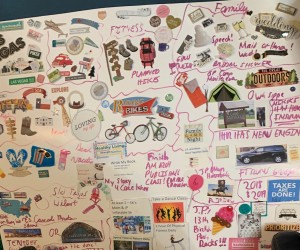What is a vision board?
The basic definition of a vision board is a visual manifestation of your goals. So, in order to create a vision board, you have to know what your goals are first!
GOALS
You have to do some deep work and plot out your goals prior to the vision boarding. Deciding on your goals and creating the visual representation of them are really two totally different exercises, and the goals have to come first.
That said, you don’t necessarily need to create a board for ALL your goals right away. If that feels too big, pick just 3 things. They could be how you want to feel, what you want to do, or a combo of both. Your goals don’t have to be perfect, and you may identify more as you work on the visual, but you at least need a few basics.
Examples of some tangible goals include becoming debt free, traveling to particular locations, moving into a new home, freeing up your time by delegating, changing your mindset.
VISION
Once you know goals that are most important, you are ready to create a powerful visual representation of them.
Here are some guidelines for creating your board:
Get a ton of different magazines, newspapers, or books that are meaningful to your goals and that you can cut things out of. If you know you want to do a lot of travel, get travel magazines. If you know you want to remodel, you may want to pick up a couple of Better Home and Garden mags. Ask friends if they have any you can have and feel free to use free ones as well.
Pick up stickers. You can get beautiful stickers from a craft store like Michael’s They have a huge selection of all kinds of stickers, and they are themed. They have a section for wedding stickers, travel stickers, life stickers…you name it. You can also order them on Amazon and look up anything you want. You can also look up “vison boarding stickers”, and you’ll get a ton of motivational phrase stickers and positive statement stickers.
Look up images online or print personal pictures of yourself, your business, or your family. I open up a Word doc and paste images in it that make the board even more personal, and print and cut those out. I recommend creating your goals as if they’ve already happened. Use words or photos like, “Mission accomplished! I made $300k this year.” as an example.
Get a board that works for you. I strongly recommend using foam boards because they are thick and look lovely when you hang them, and they are very durable. I decided to use an old canvas I found that is ruined and can’t be painted on, but it can be glued on!
Creative elements. You can order letters if you want to create words, write on washy tape and stick that on adding a powerful phrase in pen that works for you. Use glitter, paint, markers or whatever medium feels right to you.
Personalize it and pepper in meaningful items. If you have something that is meaningful to you and feels lucky or positive, tape or glue it on! A coin, a piece of string, a piece of jewelry, a crystal…whatever makes you feel jazzed, inspired, and seems to carry some magic in it when it shows up in your life is a fine addition.
A few things to note
Once everything is cut, consider the order / placement of your board. You want to create something that aligns with attracting what you want. For example, if I have two images next to each other and one says “joy” and the other says “eliminate” (meant for something else on the board), I might eliminate joy, and that would not be good. ???? So, just consider where you are placing things and how. You should feel into it and not think into it. Do your vison board in a calm headspace when you can tap into your intuition. That’s where the magic happens.
Use positive statements only. Avoid using negative statements like, “I won’t do this anymore.” That might accidentally attract the negative thing you don’t want. Instead, say, “I will do this.” and make it a positive statement for what you’d like to see instead.
Dream and get creative. This is supposed to be FUN. Your vision can be anything you want it to be, so make it amazing. Even if you think it’s a far out goal but you know you really want it, put it on there! Dream big!
Make it specific. If you want to lose weight, put a few stickers or images to represent “the how”. Add an image of a piece of exercise equipment or a photo of your gym and healthy food you’ll actually prep, or a class you’ll join during the year as examples.
Have fun with this exercise! I’d love to see what you come up with. Feel free to email me with a photo of it! 
 “Shut up, shut up, I’m busy.” were the last words radioed by the captain of the Titanic before it hit the iceberg and sank. He was warned. The ship sank because of his distraction.
“Shut up, shut up, I’m busy.” were the last words radioed by the captain of the Titanic before it hit the iceberg and sank. He was warned. The ship sank because of his distraction.








